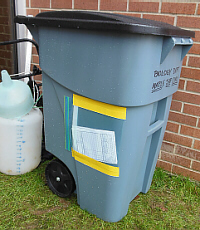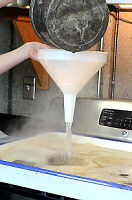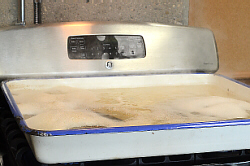Maple Sap Boiling Instructions
Procedure:
- If you’re not sure if there’s sap
waiting to be boiled, you might want to
check first with Nick
(558-7552), especially if you live a distance away.
- When you arrive to “babysit” the
boiling sap, you should first let Nick (or one of the professors — note:
Drs. Kossenjans, Hilvano, do Amaral, Fankhauser, and Clark’s offices are all “right
around the corner” from the lab area; the first ones you’ll see as you enter
the faculty office area — and my office is just around the next corner from
theirs) know you
are there. You will need one of them to let you into the lab kitchen area.
A sign in/out list will be posted so you can record the times when you arrive
and leave.

- If you are the first person that day
to watch the sap, you may need to help bring it upstairs. If the large,
gray, “garbage” can is not there in the lab kitchen, you will
(perhaps with help from Nick or a faculty member?) need to go down to the
other end of the hall, down that stairs, and out the door, then turn right
and go around the corner to where the sap-collecting supplies are kept.
If the big “garbage” can is not in the lab, it should, hopefully, be there.
It is on wheels, but getting it to go through the mud can be a challenge,
especially if it is very full — get help if needed. If it is down there,
you will need to take it into the elevator and upstairs to the lab kitchen.
Also, especially on a Monday (with collected sap from Fri, Sat, and Sun
afternoons), you should check the carboy on the backpack to make sure sap was
not left in there.


- If not there already, place the large,
flat, white pan on the stove. In that pan, set a strainer (one of the
ones with “feet” so it stands up on its own) lined with cheesecloth.

- Move the “garbage” can close to the
stove so sap doesn’t drip on the floor. Use any convenient utensil (pitcher,
small or medium pot, bucket — check with Nick) to transfer sap to the pan,
pouring it through the cheesecloth-lined strainer to catch/remove any twigs,
etc.

- Optionally, one of the brewing
funnels with a fine-mesh screen in the bottom could also be used to filter
the sap.

- Turn on the stove. If the stove
does not light, ask Nick if the “big green button” needs to be pushed.
To get the water to evaporate out of the sap in the shortest time possible,
you will need to turn all the burner on their highest setting (the
right-front burner may need to be turned down a bit if sap starts boiling
out of the pan from that corner.).

- Watch the pot — OK, you don’t have
to stand there and physically stare at it the whole time. You can sit down
and do homework. Eating in the kitchen area is OK. But, don’t forget to
periodically check the pan and see how it’s doing.

- As the water gradually evaporates,
if there is still more sap in the “garbage” can, that may periodically be
added to the pan (poured through the cheesecloth-lined strainer) to top it
off.
- When all of the sap has been emptied
out of the “garbage” can, the can can be taken out into the greenhouse and
rinsed out with the hose, then turned over to drain for a few minutes. After
the can is reasonably dried out, its lid can be securely placed back on it.
Then whole thing can be wheeled down to the elevator, taken downstairs,
and taken back outside and around the corner to the right, then placed with
the rest of the sap equipment (backpack, etc.) that is down there.
- If/When the boiling sap in the pan
is getting low (and that’s all the sap for that day, so there’s no more to
be added) and perhaps bubbly, turn it off and let Nick or a faculty member
know. Let it cool off. Once the sap has cooled enough to be safely handled,
Nick or a faculty member (perhaps with your help?) will pour it into a jug.
(Later, a faculty member will boil the collected syrup to completion,
hopefully, thereby avoiding setting off the fire alarm.) IF IN DOUBT,
TURN IT OFF!!!
- If your time is up and you’re ready
to leave, TURN OFF THE STOVE FIRST!!! (unless another student has
just arrived and will be immediately taking over).
- Before you leave, record the time on
the sign in/out list, let Nick or a faculty person know you’re leaving, and
DOUBLE-CHECK THAT THE STOVE IS TURNED OFF!!! — which is especially
important if no one else has arrived to take over, and/or if you are the
last person watching the sap on that day.
Copyright © 2015 by J. Stein Carter. All rights reserved.
Chickadee photograph Copyright © by David B. Fankhauser
This page has been accessed  times since 10 Mar 2015.
times since 10 Mar 2015.















